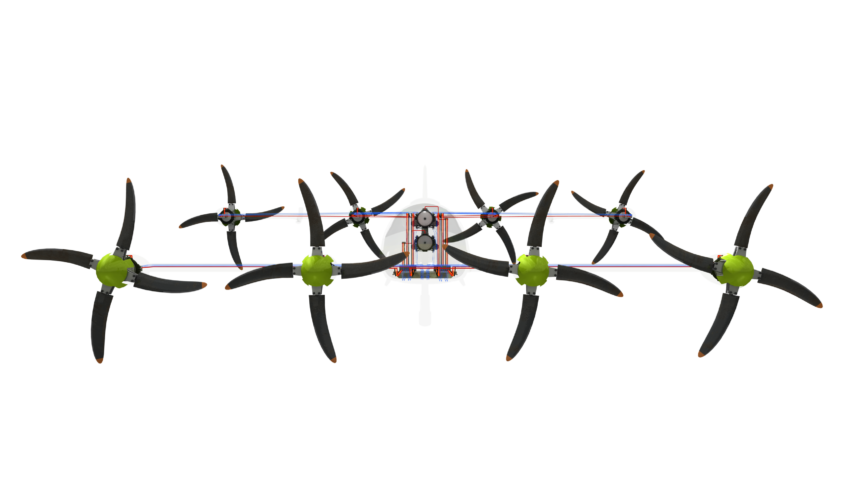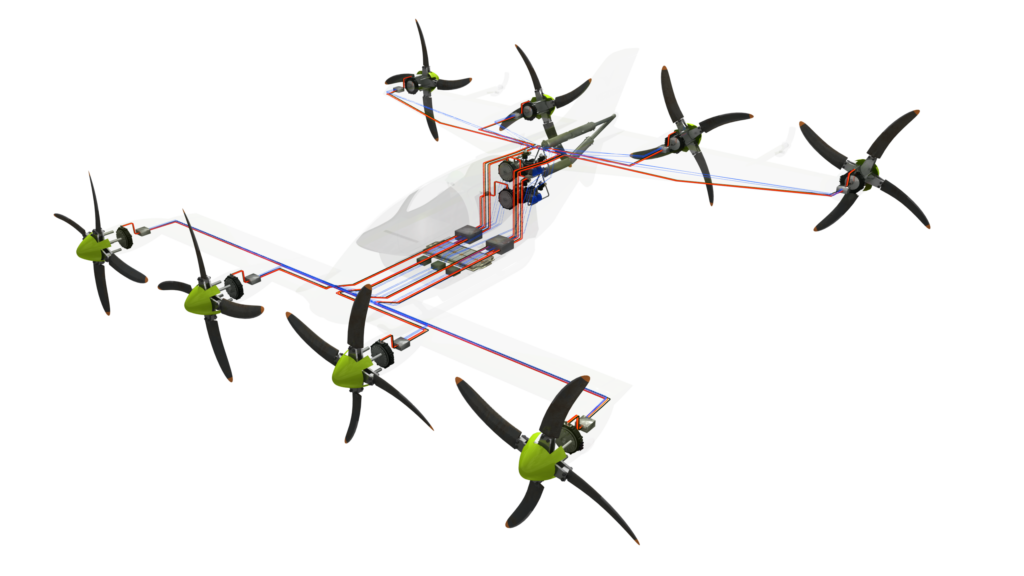VerdeGo Aero is a company from Florida working to bring innovative Urban Air Mobility solutions. Impakter has previously interviewed VerdeGo Aero’s Chief Operating Officer, Eric Bartsch, and now it is time to speak again with him as the company has announced the launch of its Integrated Distributed Electric Propulsion (IDEP) systems.
By launching its IDEP systems, VerdeGo Aero is leveraging its expertise with hybrid powertrains; electric aerospace propulsion; attitude control of Vertical Take-off and Landing (VTOL) aircraft. The final goal is very ambitious: deliver end-to-end powertrain solutions for customers in the Urban Air Mobility market.
The Urban Air Mobility market is growing fast, but many of the aircraft concepts, are clearly inspired by small-scale consumer drone designs. Unfortunately, there are critical differences in propulsion systems, aircraft control, and safety that make developing an aircraft designed to transport people, far more challenging than a lightweight drone.
VerdeGo’s modular IDEP offers aerospace industry customers a wide range of propulsion and control platforms that can be adapted to several aircraft designs. VerdeGo’s IDEP systems can be configured with a variety generators and battery packs to match the mission needs of the aircraft and the desired level of safety and performance. It will take at least fifteen or twenty years before commercial levels of performance are achieved from a purely battery-operated VTOL aircraft, but with VerdeGo’s first-generation IDEP hybrid system it will be possible for aircraft manufacturers to fly with technologies available today, with an upgrade path as soon as batteries are available.
Considering all those interesting innovations, we are glad to speak again with Eric Bartsch, VerdeGo Aero’s Chief Operating Officer.
VerdeGo Aero has changed his mission since last time we talked. Can you explain the reasons that have led you to this decision?
Eric Bartsch: VerdeGo’s mission has always been to make aviation as useful for short-range trips as it has become for longer journeys. As VerdeGo continued to develop the systems within our PAT200 aircraft and as we continued to interact with other “flying car” and urban air mobility companies, we recognized that our team has unique capabilities regarding powertrains and control of VTOL aircraft. There is a larger opportunity for VerdeGo to leverage these technologies in a variety of aircraft of different sizes and mission capabilities, rather than focusing on a single aircraft design. Therefore we have decided to pivot our strategy to become a trusted partner to other aircraft programs, to provide them with highly capable powertrain and control systems.
Can you explain exactly what you will be doing? What will you be producing? And who your clients would be?
EB: VerdeGo will be developing our IDEP (Integrated Distributed Electric Propulsion) Systems. IDEP systems consist of modular building blocks that can be utilized on a wide array of aircraft designs. Our initial IDEP systems will be hybrid-electric to ensure that they can be commercialized with technologies we have access to now.
VerdeGo is partnering with leaders in the technologies and components contained within its IDEP systems to ensure that we can deliver the best end-to-end performance for the aircraft that utilize our approach. It is critical that all of the components in the powertrain function efficiently as a system and we have developed expertise in matching the right set of components to deliver the performance and mission requirements for VTOL aircraft.
The initial products will be the IDEP-H2 hybrid system for two to three seats aircraft and the IDEP-H7 hybrid system for 5 to 7 seat aircraft designs. We also have full-battery powered designs under development, but these depend on the progress being made with advancing battery technologies. Experts currently believe that it may be 15 or more years until batteries are capable of powering a VTOL aircraft used for commercial missions, so our initial focus is on the hybrid-electric versions of IDEP.
Currently we are assessing both Rotor-based propulsion as well as Variable Pitch Propellers to ensure that our aircraft are maneuverable and stable. Our core IDEP architecture can be adapted to both.

In the Photo: Rendering of VerdeGo Aero IDEP system. Photo Credit: VerdeGo Aero.
Do you still believe the eVTOL market is going to be fast growing over the next couple of years?
We remain very enthusiastic about the emergence of the eVTOL market. Between now and 2023 there are many aircraft programs going through the development and certification process. We see a huge potential for Urban Air Mobility to become a multi-billion dollar global transportation market that supports multiple sizes and configurations of eVTOL (or hVTOL hybrid) aircraft.
How much battery technology has improved since our last chat? Are you working and developing those as well?
Battery technology has been on a long-term improvement path of 3 to 5% per year for energy density improvement for decades. There has been very little progress since our last call and we expect that it may take 15 or more years for batteries to advance to where VerdeGo believes they need to be for commercial missions. We are working with the latest battery technologies and one of our advisory board members is one of the leading global experts in battery technology for electric vehicles so we are very aware of the latest progress. For the long term we are very excited about the potential for fully battery powered VTOL aircraft, however in the short term there are significant performance gaps and VerdeGo is ensuring that the industry can proceed with confidence regardless of the rate of progress in the battery industry. Our IDEP systems are designed to be adapted for battery power as soon as cells are available that pass our requirements for performance and safety.
In which country do you believe there will be a good market for what you are building? Are the USA still going to be your main market?
Urban Air Mobility is a very global market. Most of the largest mega-cities are outside the US so all urban air mobility companies need to be global. The US is an important market, but there are also huge needs for rapid transportation options in cities around the planet. We look at cities like New York, Los Angeles, Miami, Beijing, Shanghai, Tokyo, Sao Paulo, Mexico City, Dubai, Delhi, Mumbai, London, Paris, Hong Kong and Singapore as good examples of locations where there is a significant need for short-range air mobility.

In the Photo: Rendering of VerdeGo Aero IDEP system. Photo Credit: VerdeGo Aero.
Will electric or hybrid aircraft- making companies be able to use some of your technology as well?
VerdeGo’s primary focus is to enable aircraft manufacturers to successfully develop new types of aircraft that are optimized with electric propulsion. The most significant market for our IDEP systems will be vertical takeoff and landing aircraft, but there may also be fixed-wing aircraft designs that could benefit from using our systems for distributed electric propulsion. We have moved away from our aircraft program to ensure that we can be a partner to other aircraft companies and not a competitor. Many eVTOL aircraft companies have their roots in the consumer drone world. While there is much that we can learn from consumer drones, there are also very real physics limitations to the approaches used in a small 2kg drone. VerdeGo’s IDEP systems are ideal for aircraft that weigh 750kg up to 3000kg or more, and our hybrid architecture means that we have sufficient energy to deliver missions that are commercially useful, with safety margins that comply with current FAA and EASA requirements. VerdeGo is already talking with several aircraft companies about applying its modular IDEP systems in their aircraft.

In the Photo: Rendering of VerdeGo Aero IDEP system. Photo Credit: VerdeGo Aero.
Have you been to the latest Uber elevate summit in May? If so what are your thoughts about this edition?
VerdeGo attended both the 2017 and 2018 Uber Elevate events and it was impressive to see how many innovators from around the world are working to make urban air mobility a reality. Uber’s support for Urban Air Mobility has been extremely helpful in building momentum for this entire industry. It is also exciting to see how the industry has grown beyond Uber to include many different aircraft operators and operating concepts. Since Uber is not planning on developing aircraft, purchasing aircraft fleets, or operating aircraft it is very important that these other companies are showing strong interest in being urban air taxi operators around the world. It was exciting to see so many companies at Uber Elevate with business models that sometimes align with Uber and sometimes are an alternate vision for how this market will grow. This diversity of viewpoints is necessary as we build a multi-billion dollar transportation industry that can support different types of operations in different markets around the world.
We agree with Uber’s long-term vision for how this industry will transform urban mobility, but their vision skips several steps into the future as they show what a very large-scale aerial transportation network may look like decades in the future. We love their vision for what the $20B+ mega-scale version of urban air mobility looks like, but VerdeGo is also very concerned about how we get started during the 10 to 20 years that it takes to scale up to that level. This is why VerdeGo’s IDEP systems are based on real existing technologies we can access now, and not hypothetical future technologies with an uncertain development path. We like to say that difficult engineering projects can be completed on a schedule while fundamental scientific research can not. It is important to recognize which urban air mobility concepts are viable through engineering components we have now, and which concepts require fundamentally new scientific discoveries that are difficult to plan for. This is why the hybrid-electric versions of IDEP are first on our roadmap, to ensure that the aircraft developers working with VerdeGo Aero have access to the systems they need to make their aircraft successful years earlier than their competition.










